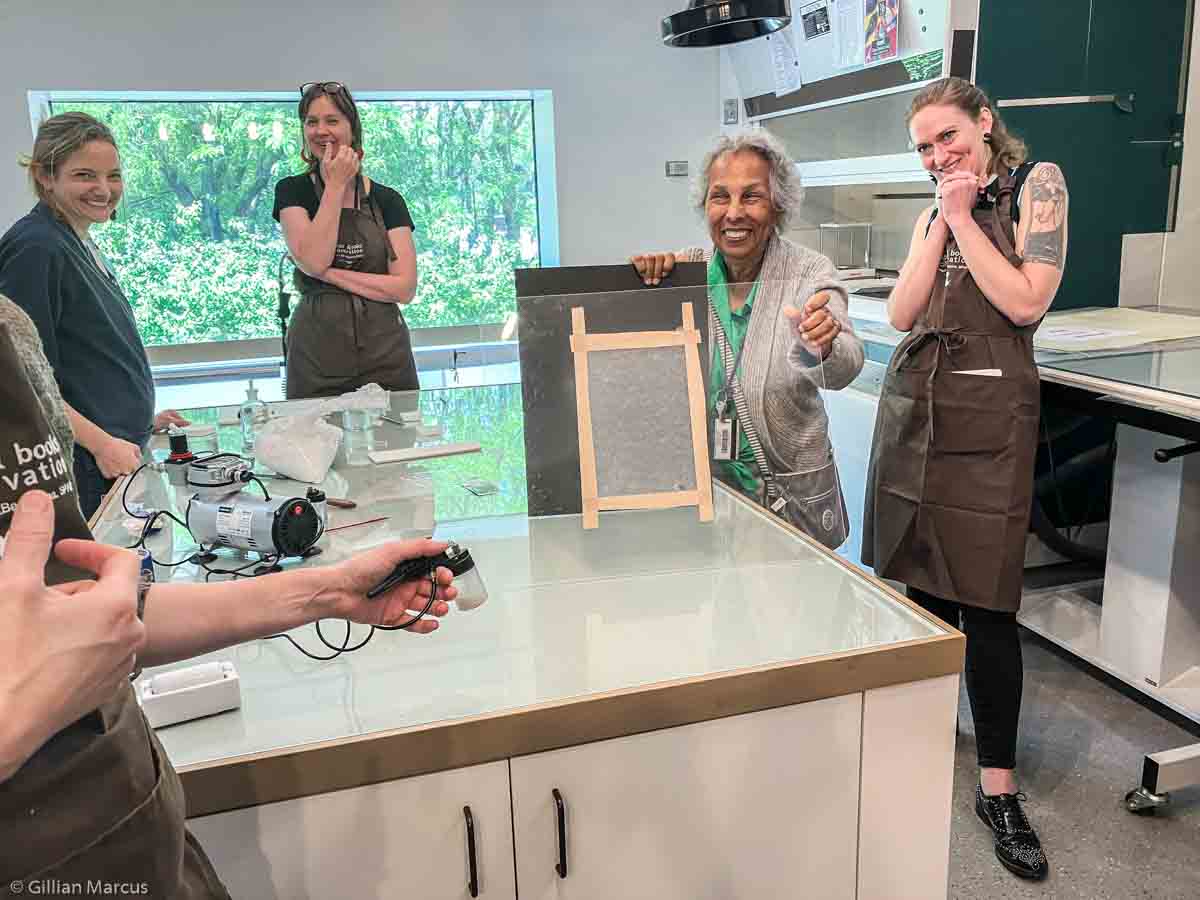TRAINING/RESEARCH
Find below the portfolio projects related to TRAINING/RESEARCH:
Workshop: Match your Infill (The Hague, 2024)
Techniques, materials and products to infill and in-paint. Mould casting of textures (either acrylic or cellulose powdered based), matching colour with paper pulp, dyes and colorants, colour, digital retouch, tips and tricks for retouching.
Course: Match your infill (London, 2024)
Techniques, materials and products to infill and in-paint. Mould casting of textures (either acrylic or cellulose powdered based), matching colour with paper pulp, dyes and colorants, colour, digital retouch, tips and tricks for retouching.
Course: Match your infill (Tartu, 2024)
Techniques, materials and products to infill and in-paint. Mould casting of textures (either acrylic or cellulose powdered based), matching colour with paper pulp, dyes and colorants, colour, digital retouch, tips and tricks for retouching.
Session: Use of paper pulp on paper conservation (Amsterdam, 2024)
Questions and answers session about the use of paper pulp in paper conservation. Dry application, wer, on suction table, manual and leaf-casting machine. Discussion of types and qualities, and how to adjust the colour.
Course: Match your infill (Mohammed Bin Rashid Al Maktoum Foundation, 2023)
Techniques, materials and products to infill and in-paint. Techniques, materials and products to infill an in-paint. Use of micro-powdered cellulose in paper conservation, mould casting of textures (either acrylic or cellulose powdered based), matching colour with paper pulp, dyes and colorants, digital retouch, colour, tips and tricks for retouching.
Course: Match your infill (Prague, 2023)
Techniques, materials and products to infill and in-paint. Techniques, materials and products to infill an in-paint. Use of micro-powdered cellulose in paper conservation, mould casting of textures (either acrylic or cellulose powdered based), matching colour with paper pulp, dyes and colorants, digital retouch, colour, tips and tricks for retouching.
Course: Match your Infill (Art Institute of Chicago, 2023)
Techniques, materials and products to infill and in-paint. Techniques, materials and products to infill an in-paint. Use of micro-powdered cellulose in paper conservation, mould casting of textures (either acrylic or cellulose powdered based), matching colour with paper pulp, dyes and colorants, digital retouch, colour, tips and tricks for retouching.
Course: Match your infill (València, 2023)
Techniques, materials and products to infill and in-paint. Techniques, materials and products to infill an in-paint. Use of micro-powdered cellulose in paper conservation, mould casting of textures (either acrylic or cellulose powdered based), matching colour with paper pulp, dyes and colorants, digital retouch, colour, tips and tricks for retouching.
Course: Match your infill (Leiden, 2023)
Techniques, materials and products to infill and in-paint. Mould casting of textures (either acrylic or cellulose powdered based), matching colour with paper pulp, dyes and colorants, colour, digital retouch, tips and tricks for retouching.
Course: Identificaction, conservation and preservation of photographs (Oslo, 2022)
Workshop with theoretic and practical sessions. Organization: National Museum (Oslo, Norway). Language: English. Dates: December 6-7th, 2022. Audience: Professional paper and photographs conservators.
Course: Inpainting and Loss Compensation on Paper Conservation (Oslo, 2022)
Techniques, materials and products to infill and in-paint. Use of micro-powdered cellulose in paper conservation, mould casting of textures, matching colour with paper pulp, dyes and colorants, colour, light, tools, criteria, un-restoration, digital retouch, tips and tricks for retouching.
Tailored workshop: Photographs, carte-de-visite and autographs conservation (Premià, 2022)
Tailored workshop: Conservation of photographs, cdv and autographs. General treatments (dry cleaning, tear repair, flattening). Chemical aspects of conservation (deacidification, chelating agents).
Lecture: Sewing, adhesion and grain direction in book conservation
Event: AIC 50th Annual Meeting, [...]
Preservation, housing, mounting and framing artwork on paper (Valls, 2021)
Which is the best way to preserve paper artefacts? How are they mounted and framed for exhibition? Technical session explaining products, materials & techniques.
Lecture: ‘Conservation of recycled bindings and fragmentology’ (Parts 1 & 2), SICP Chile
Book conservation involves a tough decision making regarding usability and long term preservation handling. Sometimes we are dealing with fragmentology, or disjecta membra (fragments of written supports are re-used as part of a binding, with a diverse purpose from the first use) whereas in other cases the purpose is the same, and the whole binding is being recycled to bind a different book. Incunabula and manuscripts with laced-case and limp vellum bindings are studied.
Workshop: Wet treatments of
Works on Paper (Amsterdam, 2021)
Theoretical and practical sessions. When to apply wet treatments on paper, and how. From the basis of handling wet paper to more complex moisturizing, humidification and washing techniques. Fugitivity tests, types of inks and their properties, and many case studies to show conservation treatments on real artwork: manuscripts and documents, drawings, watercolours, pastels, charcoal drawings...
Workshop: Wet treatments
of Works on Paper (Köln, 2021)
Theoretical and practical sessions. When to apply wet treatments on paper, and how. From the basis of handling wet paper to more complex moisturizing, humidification and washing techniques. Fugitivity tests, types of inks and their properties, and many case studies to show conservation treatments on real artwork: manuscripts and documents, drawings, watercolours, pastels, charcoal drawings...
Lecture: ‘Conservation of reused bindings’ (Part two), Dubrovnik
Book conservation involves a tough decision making regarding usability and long term preservation handling. Sometimes we are dealing with fragmentology, or disjecta membra (fragments of written supports are re-used as part of a binding, with a diverse purpose from the first use) whereas in other cases the purpose is the same, and the whole binding is being recycled to bind a different book. Incunabula and manuscripts with laced-case and limp vellum bindings are studied.
Workshop: Preservation, housing, mounting and framing artwork on paper (Tortosa, 2021)
Which is the best way to preserve paper artefacts? How are they mounted and framed for exhibition? Technical session explaining products, materials & techniques.
Lecture: ‘Conservation of re-used bindings’ (part one), Zagreb
Book conservation involves a tough decision making regarding usability and long term preservation handling. Sometimes we are dealing with fragmentology, or disjecta membra (fragments of written supports are re-used as part of a binding, with a diverse purpose from the first use) whereas in other cases the purpose is the same, and the whole binding is being recycled to bind a different book. Incunabula and manuscripts with laced-case and limp vellum bindings with rolled sewing on parchment are studied.
Clients
Filter project by:
ARTEFACT
artwork on paper
drawings
maps, plans (architectural drawings)
posters
board or paper artefacts
books
albums
bindings conservation
codexs
fragmentology (membra disjecta)
recycled binding
incunabula
limp parchment binding
paperback books
sewn unsupported with drawn-on covers
stationery bindings
documents
holdings (archive/library)
oversized
photographs
albumens
daguerreotypes
silver-gelatin
glass-plates
silver-gelatine paper photographs
MATERIALS
TECHNIQUE
ball-point pen
charcoal, pastel
cyclostiled
felt-tip pen
gouache
graphite, pencil
manuscripts
prints
engraving
lithograph
watercolor
woodcut
TRAINING/RESEARCH
courses
book conservation
housing, mounting and framing paper artworks
introduction to paper conservation
Matching infills & retouching
photograph conservation
tailored conservation course
wet treatments
exhibitions
lectures
teaching materials
translation
TREATMENT





















